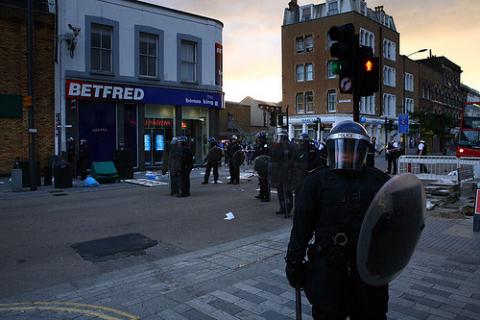Violence at the edge: Tottenham, Athens, Paris

The experience of police harrassment and violence is an everyday one for many people in many communities, and we need to interrogate the idea that such aggression is automatically legitimate. By Illan Rua Wall.
Few are willing to make comparisons between this past year’s radical poitical activity – from the student protests to the major TUC demonstration – and the Tottenham riots. The reasons for this are fairly obvious: there is no unifying political goal of these ‘looters’, ‘hooligans’ and ‘thugs’. Theirs instead appears to be a ‘consumerism of the excluded’ – as someone quipped recently. But there is a common denominator – that is the role of the police in patrolling the fringes of ordered liberal society.
The response to every and any hint that the police might have behaved badly is remarkably similar in so many instances. Firstly, denial: ‘he shot first’, ‘he moved towards me’, ‘he was being restrained for his own safety’. Then, if the pressure is great enough and the evidence obvious enough: acceptance and repentance. This comes with promises that any bad apples will be sought out, plucked from the tree and binned. Then finally, when the fury has dissipated, charges and complaints are dropped, or one person takes the hit – rarely anything beyond a slap on the wrist. As Alex Wheatle says, no police officer has ever been convicted for the death of a black person in custody. This should not surprise us. The police will close ranks in an attempt to protect their own. The political and legal establishment will tolerate this to a certain extent. They recognise ‘the difficult job that officers do’. Yet, this type of reasoning misses the everyday and ordinary violence of the police, and by extension that of the state (and the law). A different way of looking at this emerges when we refuse to accept, for a moment, that police violence is automatically legitimate.
To begin to unpack the events of the last three days, it is interesting to trace a certain pattern: After some perceived or minor indiscretion, the police respond with overwhelming force (this is Thereasa May and Tim Godwin’s solution as well). Mark Duggan apparently ‘threatened the safety’ of the SO19 police officer who then shot him dead. Then at the protest about his death at the Tottenham police station, a ‘16-year-old girl ‘threw something, maybe a stone, at the… riot police line’. [But]… this was met with a furious response, with around 15 riot officers pounding her with shields.’ With that the crowd surged forth and the violence of the past days began. But this is a pattern common to a number of this similar events. Take for instance, the Banlieue riots of 2005 (which have continued to bubble over ever since). These began when teenagers, Zyed Benna and Bouna Traoré, were electrocuted in a sub-station following a police chase. Equally, the Christmas 2008 Athens riots began with the murder of Alex Grigoropoulos by two police officers after a verbal altercation.
In other words, there is a tinderbox of social tension bubbling just below the surface. A precarious population, always tainted with the suspicion of illegality: In Greece this was the mass of unemployed youth, constantly harassed by the police, in France the economic and racialised ‘others’ of the Banlieues, and in Tottenham and round East and South London there is a segment of the population which is routinely stopped and searched on the apparent ground of guns, or drugs, or whatever. These people are the objects of authorised violence. The everyday experience of liberal capitalism rests upon the violent defence of the boundaries against the other that the system itself produces. That banal and pacifying phrase ‘social exclusion’ allows us to forget the material experience of exclusion and the subjectivities that it tends to generate. The final straw in this case was Duggan’s death and the riot squad’s over-reaction to a stone – all that was kept together by habitual obedience and ritual humiliation dissolved. The experience of precariousness, suspicion and everyday routine exclusion resolved itself into one overwhelming return of the repressed. London witnessed, once more, the stones, flames and the violation of property that comes with every exclusion.
This content is published under the Attribution-Noncommercial-No Derivative Works 3.0 Unported license. Originally posted on Critical Legal Thinking.
Image top: hozinja.
